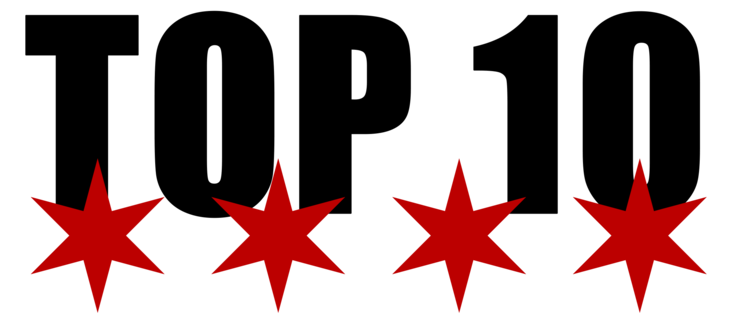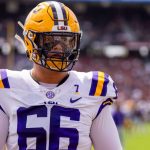Johnny Morris remains the all-time career leader in receiving yards for the Chicago Bears. An incredible reality given he stopped playing football in 1967. Over the years there have been several challenges to his record. Willie Gault got off to a good start over five years but was traded in 1988. Curtis Conway had great run early in his career before injuries got in the way. Brandon Marshall and Alshon Jeffery both looked like virtual guarantees to break it. Then the former was traded and the latter left as a free agent. Not enough people remember the name Marcus Robinson.
Maybe that shouldn’t be a surprise. The man came out of Fort Valley, Georgia. A town with a population of less than 10,000 today. Imagine what it probably was back in the 1970s. However, one thing the town became known for by the 1980s was football. Slowly but surely a number of its young men began to find their way to the NFL
None became more of a household name than Greg Lloyd. After starring in high school, he attended Fort Valley State University. There he accomplished enough to become a 6th round pick of the Pittsburgh Steelers. He would go on to become a five-time Pro Bowler with 54.5 sacks. Except there was one asterisk next to his name. Lloyd was not a native of Fort Valley. He’d been born in Miami, Florida.
Robinson was pure blood of the town and wanted a chance to become just the eighth player in the town’s history to reach the NFL.
Subscribe to the BFR Youtube channel and ride shotgun with Dave and Ficky as they break down Bears football like nobody else.
Marcus Robinson begins his climb to the top
Robinson wasn’t just a star football player in Fort Valley. He was a star athlete. He was an All-American and All-State player for Peach County High School. Not only as a wide receiver too. He also did work as a safety and a punter. When he wasn’t dominating the gridiron, he was smoking opponents on the track, winning regional championships in the 100 and 200-meter dashes.
These exploits got Robinson widely recruited. He decided to stick closer to home by attending the University of South Carolina. It seemed like a smart decision at the time. The college had recently done a tremendous job of churning out great receivers for the NFL. Sterling Sharpe was drafted in 1988 and became a five-time Pro Bowler. Robert Brooks followed in 1992. He had over 4,200 yards and 32 touchdowns in just 100 career games while winning a Super Bowl with Green Bay.
Unfortunately, Robinson arrived at a bad time. The man who had recruited both of those players to South Carolina, Joe Morrison, was gone by 1989. His offenses had been built around throwing the football. Not surprising since the man was a former receiver himself. Robinson came in under the direction of Sparky Woods. While he was a former QB himself, he was also a former defensive back.
Thus the passing game wasn’t exactly proficient under his watch.
It was apparent he didn’t know what he had in Robinson either, who only caught three passes as a freshman. Matters soon became even more complicated for the young receiver when Woods was fired after the season ended, ushering in the era of Brad Scott. It seemed like a dream come true. Scott had delivered a dynamic offensive show at Florida State while winning a national championship. He loved to open things up.
There was one problem though. Scott wasn’t good at identifying or developing great receivers.
During his time at FSU, the Seminoles saw six receivers get drafted who played under him. Only one (Lawrence Dawsey) became a starter in the NFL. Sure enough, Scott built his South Carolina offense around a twin set of running backs. Receivers were involved but not the focal point. As a result, Robinson caught just 13 passes over his sophomore and junior seasons.
Even by 1996 in his senior year, he still only caught 21 as a starter. The saving grace for him was that they amassed 505 yards (24 per catch). That, along with his size (6’3) and strong scouting combine was enough to get him noticed by the NFL. On April 20th, 1997, the Chicago Bears selected him in the 4th round.
Right back where he started
Robinson may have reached the big time, but it’s likely that about midway through his second year in Chicago he must’ve felt like he was at South Carolina all over again. Bears head coach Dave Wannstedt had a reputation. It seemed unless a player was a high draft choice, there was no way you’d get a chance to see the field early in your career.
This proved the case for Robinson. After missing his rookie year with a thumb injury, the Bears agreed to send the young receiver over to Germany to participate in NFL Europe. There he played for the Rhein Fire. Part of the reason was to knock off the rust, but also it was a chance to showcase to the world that he was more than a “project” player.
He didn’t waste time. Robinson delivered 41 catches for 925 yards and six touchdowns in 10 games. The Fire tied for the best record in the league at 7-3 and crushed the Frankfurt Galaxy in the 1998 World Bowl for the league championship. He may have made the pivotal play of the game too. Frankfurt had narrowed the score to 17-10 in the 3rd quarter. Then Robinson hit them with a backbreaking 74-yard touchdown catch.
He was named offensive MVP that year.
Unfortunately, that didn’t seem to impress Wannstedt. When Robinson got back from Europe, it was almost the same exact situation as when he’d left.
“I went over there because I just wanted to play football,” he said. “Then all of a sudden, bam, my first three games I had 100 yards receiving. I came back and I figured, `OK, I proved I can do it, they saw the film, that must amount to something.’ I was feeling pretty good about being the third or fourth wide receiver, but there I was in the same spot, fifth or sixth all over again.”
The coach’s stubbornness ended up costing him. Chicago’s passing game was even worse in 1998, finishing 23rd. The Bears went 4-12 for the second-straight year. Robinson appeared in just three games and caught four passes. Despite that, he found a way to make an impact. In one of those few wins that year, a 31-27 thriller over Detroit, he caught a 20-yard touchdown from Erik Kramer. It was the Bears’ first score of the game and finally got the offense going after a dismal 1st quarter.
Wannstedt was fired. If he didn’t see the value in the young receiver, maybe somebody else would.
An epic season nobody saw coming
Sometimes the thing that is needed in order to kickstart a career is a fresh start. Robinson got his when the Bears hired Dick Jauron as their new head coach. With him, he brought a young offensive coordinator named Gary Crowton. Before arriving in Chicago, Crowton had been the offensive coordinator at Louisiana Tech where he developed a reputation for a wide open offense. He liked to throw the football and knew how to develop receivers.
One of his prized players, Troy Edwards, was the 13th overall pick that year and would play 92 games in the NFL.
“The offense was fun. It was an upbeat offense. We ran a lot of swing passes and things like that. They got the ball in your hand, and I developed that practice of being able to go up for the football.”
Sure enough, it didn’t take Crowton long to recognize the potential ability the third-year receiver had. By the time the season kicked off in September of that year, Robinson was elevated to the top three on the wide receiver depth chart. He celebrated with four catches for 47 yards in his first game.
For the first few weeks, he was a steady contributor but hadn’t really established himself. That all changed during a trip to Minnesota. Facing the defending NFC Central champion Vikings, the Bears had been crushed the previous year up there 48-22. Robinson ensured that wouldn’t happen again, catching four passes for 136 yards and a touchdown. Chicago prevailed 24-22. One of their few bright spots of that season.
For Robinson, it was a moment the beast had awakened.
Between October 17th and December 19th of that season, Robinson would have games of 136, 161, 148, 163, and 170 yards. One of the most dominant stretches a Bears receiver has ever had. He finished the year with 1,400 yards, a franchise record that would stand for the next 13 years. What made it all the more impressive is how he did it.
Robinson didn’t have a Steve Young, Brett Favre or Peyton Manning throwing him the ball. He produced that season with three different quarterbacks passing it: Shane Matthews, Jim Miller, and Cade McNown. This would be something the receiver always had a problem with according to Jack M. Silverstein of Windy City Gridiron.
“You would come in on Saturdays and they would be like, ‘Okay, Jim Miller’s starting this week,’” says a still incredulous Robinson with a laugh. “‘Okay, we’re going to let Cade start.’ This would be on a Saturday before the Sunday game.”
Still, Robinson did appreciate one thing. The Bears coaches allowed him a much freer hand to get calls changed if he saw an opportunity for a big play. Something he took advantage of frequently that year. There was no doubt. Chicago appeared to have a superstar in their midst.
His greatest regret
The next year, Robinson remained a steady and dangerous threat through the first 10 games of 2000. He didn’t have any explosive games like the year before but he was on track for his second-straight season over 1,000 yards (741 yards with six to play). Then in a game against the New York Jets, he suffered an injury to his back. It knocked him out of the contest and the remainder of that season.
Nobody knew it at the time, but this would start a tragic trend for the receiver that would ruin his career.
The next year in 2001, everybody felt the Bears might have something. Their defense had been greatly bolstered by the arrival of Brian Urlacher and Mike Brown the year before. They had a new presence at running back in Anthony Thomas. Jim Miller had finally won the starting QB job. If Robinson returned to form, this team looked dangerous.
Things started out well.
After being blanked in the opener by the defending champion Ravens, Robinson exploded over the next two games for 213 yards and two touchdowns. This sparked a run of victories for the Bears that would go on for the next six weeks. Unfortunately, he wouldn’t be there to see it.
During a game in Cincinnati, Robinson was on course for a big day. He’d just made his fifth catch of the game for 23 yards when two Bengals tackled him. The contact led to tearing of both the ACL and LCL in his left knee. A devastating injury that would prove destructive to his career. Yet as painful as that was, what hurt the most for him was not being part of the rest of that season.
“It was rough. It was rough,” Robinson lamented. “I came back and was playing really well. … We went 13-3 that year, man. If I would have been able to play, we could have—ugh. It was definitely frustrating.”
There is no question the Bears missed Robinson in the playoffs. Against Philadelphia, their passing game was utterly inept. Miller and Matthews combined for 89 yards and three interceptions. The Eagles defensive backs pretty much had their way with Chicago’s receivers. Had he been there, things might’ve gone differently.
Wanting out
By the start of 2002, things had changed for Robinson. The Bears coaching staff, with new coordinator John Shoop, didn’t feel they could wait on him any longer. They had another young receiver in Marty Booker who was ascending and also their 1st round pick from the year before David Terrell to develop. Not to mention the desire to get more speed on the field, which explains why Dez White got more action as well.
Despite making it through all 16 games that season, Robinson was targeted just 52 times. He made 21 catches for 244 yards and 3 touchdowns. By the end of the year in what was another losing season, he’d had enough. In April of 2003 before the draft, the Bears granted him his release. DIck Jauron lamented what could’ve been.
“He wanted his release. This was in the best interests of Marcus, not necessarily the Bears. We try to do what’s in the best interests of our players. We appreciate what he’s done for us.”
Anxious to show people that he still could play, he signed with the Baltimore Ravens. Unfortunately, like the Bears, they were in the midst of a major quarterback crisis with names like Kyle Boller and Anthony Wright as their primary options. Thus the opportunities weren’t as plentiful as he’d hoped. Nonetheless, he still showed flashes of that old 1999 magic.
Getting the last word
Robinson left Baltimore after one year. His desire by 2004 was to join a playoff-caliber team that had an established quarterback. His choice, much to the dismay of Bears fans, was the Minnesota Vikings. Between that season and 2005, he made 78 catches for 1,172 yards and 13 touchdowns. Not bad considering he was sharing targets with Randy Moss.
He helped the Vikings make the playoffs that first year and even managed to show everybody what he might’ve done four seasons back for Chicago. On a cold day in Philadelphia, when the rest of the offense was struggling, he delivered one of his best games of the season with five catches for 119 yards and a touchdown.
How did the Vikings show their appreciation? By cutting him on Christmas Eve the next year. The move came as a surprise given he led the team in touchdown receptions. The team offered no explanations to him. All he could theorize was head coach Brad Childress got offended when Robinson expressed concern that there was a lack of communication between players and coaches.
In an interview Sunday afternoon, Robinson said he and some other players have “a total lack of communication” with Childress, and said that offensive coaches rarely heed suggestions or other input from players. That sentiment corroborates a recent statement from quarterback Brad Johnson, who lost his starting job a day after saying he and Childress “never talk.”
Robinson failed to make it on another roster after that. Rather than continue to hold out hope, in June of 2008 he requested that he be allowed to retire with the Bears. They gave him a one-day contract and he officially stepped away on the 9th. He’d played his last game before the age of 32.
The great what-if
To this day it’s hard not to wonder how things might’ve been different for the Bears had Robinson avoided those injuries in 2000 and 2001. Not only did they rob him of that extra gear he seemed to have, but they also killed the confidence the Bears coaches had him in. Imagine if he had avoided them and was still firmly planted in the offense by the time Lovie Smith arrived.
Robinson would’ve been 32 going into that 2006 season. Keep this in mind. That year, despite his banged-up body state, he still had 381 yards and four touchdowns in just 10 games. That would’ve made him the third-most productive receiver on the Bears offense that year. If they had a healthier version of him? Maybe, just maybe Super Bowl XLI would’ve gone differently.
If nothing else, his legacy would be far different. Prior to the knee injury, Robinson had 2,407 receiving yards in just 32 games as a starter. It’s hard to imagine he wouldn’t have broken Morris’ long-standing franchise record of 5,059 yards for a career.
Another tough reminder of how cruel and unforgiving the world of professional sports can be. Especially football. Still, what Robinson was able to accomplish for that ever-so-brief window at the dawn of the new millennium is deserving of high praise and a permanent place in Bears lore.
Not to mention as a reminder of what happens when you give players an opportunity. Something the new generation of coaches and executives at Halas Hall learned well.












